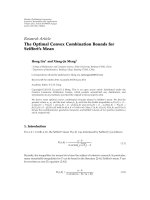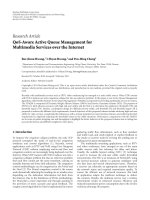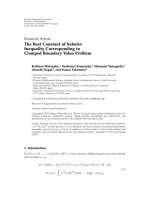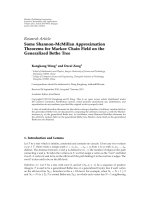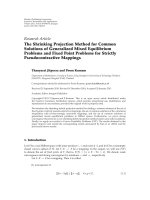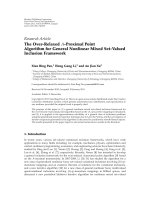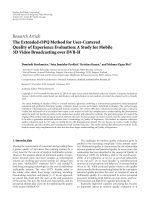Báo cáo hóa học: " Research Article The Optimal Convex Combination Bounds for Seiffert’s Mean" doc
Bạn đang xem bản rút gọn của tài liệu. Xem và tải ngay bản đầy đủ của tài liệu tại đây (481.16 KB, 9 trang )
Hindawi Publishing Corporation
Journal of Inequalities and Applications
Volume 2011, Article ID 686834, 9 pages
doi:10.1155/2011/686834
Research Article
The Optimal Convex Combination Bounds for
Seiffert’s Mean
Hong Liu
1
and Xiang-Ju Meng
2
1
College of Mathematics and Computer Science, Hebei University, Baoding 071002, China
2
Department of Mathematics, Baoding College, Baoding 071002, China
Correspondence should be addressed to Hong Liu,
Received 28 November 2010; Accepted 28 February 2011
Academic Editor: P. Y. H. Pang
Copyright q 2011 H. Liu and X J. Meng. This is an open access article distributed under the
Creative Commons Attribution License, which permits unrestricted use, distribution, and
reproduction in any medium, provided the original work is properly cited.
We derive some optimal convex combination bounds related to Seiffert’s mean. We find the
greatest values α
1
, α
2
and the least values β
1
, β
2
such that the double inequalities α
1
Ca, b1 −
α
1
Ga, b <Pa, b <β
1
Ca, b1 − β
1
Ga, b and α
2
Ca, b1 − α
2
Ha, b <Pa, b <
β
2
Ca, b1−β
2
Ha, b hold for all a, b > 0witha
/
b. Here, Ca, b, Ga, b, Ha, b,andPa, b
denote the contraharmonic, geometric, harmonic, and Seiffert’s means of two positive numbers a
and b, respectively.
1. Introduction
For a, b > 0witha
/
b,theSeiffert’t mean P a, b was introduced by Seiffert 1 as follows:
P
a, b
a −b
4arctan
a/b
− π
.
1.1
Recently, the inequalities for means have been the subject of intensive research. In particular,
many remarkable inequalities for P can be found in the literature 2–6.Seiffert’s mean P can
be rewritten as see 5,equation2.4
P
a, b
a −b
2arcsin
a −b
/
a b
. 1.2
2 Journal of Inequalities and Applications
Let Ca, ba
2
b
2
/ab,Aa, bab/2,Ga, b
√
ab,andHa, b2ab/ab be
the contraharmonic, arithmetic, geometric and harmonic means of two positive real numbers
a and b with a
/
b.Then
min
{
a, b
}
<H
a, b
<G
a, b
<P
a, b
<A
a, b
<C
a, b
< max
{
a, b
}
. 1.3
In 7,Seiffert proved that
P
a, b
>
3A
a, b
G
a, b
A
a, b
2G
a, b
,P
a, b
>
2
π
A
a, b
, 1.4
for all a, b > 0witha
/
b.
In 8, the authors found the greatest value α and the least value β such that the double
inequality
αA
a, b
1 −α
H
a, b
<P
a, b
<βA
a, b
1 −β
H
a, b
1.5
holds for all a, b > 0witha
/
b.
For more results, see 9–23.
The purpose of the present paper is to find the greatest values α
1
,α
2
and the least
values β
1
,β
2
such that the double inequalities
α
1
C
a, b
1 −α
1
G
a, b
<P
a, b
<β
1
C
a, b
1 −β
1
G
a, b
,
α
2
C
a, b
1 − α
2
H
a, b
<P
a, b
<β
2
C
a, b
1 −β
2
H
a, b
1.6
hold for all a, b > 0witha
/
b.
2. Main Results
Firstly, we present the optimal convex combination bounds of contraharmonic and geometric
means for Seiffert’s mean a s follows.
Theorem 2.1. Thedoubleinequalityα
1
Ca, b1 − α
1
Ga, b <Pa, b <β
1
Ca, b1 −
β
1
Ga, b holds for all a, b > 0 with a
/
b if and only if α
1
2/9 and β
1
1/π.
Proof. Firstly, we prove that
P
a, b
<
1
π
C
a, b
1 −
1
π
G
a, b
,
P
a, b
>
2
9
C
a, b
7
9
G
a, b
,
2.1
for all a, b > 0witha
/
b.
Journal of Inequalities and Applications 3
Without loss of generality, we assume that a>b.Lett
a/b > 1andp ∈{2/9, 1/π}.
Then 1.1 leads to
P
a, b
−
pC
a, b
1 −p
G
a, b
bP
t
2
, 1
− b
pC
t
2
, 1
1 −p
G
t
2
, 1
b
pt
4
1 −p
t
3
1 −p
t p
t
2
1
4arctant − π
f
t
,
2.2
where
f
t
t
4
− 1
pt
4
1 −p
t
3
1 −p
t p
− 4arctant π.
2.3
Simple computations lead to
lim
t →1
f
t
0, lim
t →∞
f
t
1
p
− π,
f
t
t − 1
2
t
2
1
pt
4
1 −p
t
3
1 −p
t p
2
g
t
,
2.4
where
g
t
−
4p
2
p −1
t
6
− 2
5p − 1
t
5
− 3
5p − 1
t
4
4
2p
2
− 5p 1
t
3
− 3
5p − 1
t
2
− 2
5p − 1
t − 4p
2
− p 1.
2.5
We divide the proof into two cases.
Case 1 p 2/9.Inthiscase,
g
t
1
81
47t
4
76t
3
78t
2
76t 47
t − 1
2
> 0, for t>1.
2.6
Therefore, the second inequality in 2.1 follows from 2.2–2.6. Notice that in this case, the
second equality in 2.4 becomes
lim
t →∞
f
t
9
2
− π>0.
2.7
4 Journal of Inequalities and Applications
Case 2 p 1/π.From2.5,wehavethat
g
1
8
2 −9p
8
2 −
9
π
< 0, lim
t →∞
g
t
∞, 2.8
g
t
−6
4p
2
p − 1
t
5
− 10
5p − 1
t
4
− 12
5p − 1
t
3
12
2p
2
− 5p 1
t
2
− 6
5p − 1
t − 10p 2
2.9
g
1
24
2 −9p
24
2 −
9
π
< 0, lim
t →∞
g
t
∞, 2.10
g
t
−30
4p
2
p −1
t
4
− 40
5p − 1
t
3
− 36
5p − 1
t
2
24
2p
2
− 5p 1
t − 30p 6,
2.11
g
1
8
17 − 70p − 9p
2
8
17 −
70
π
−
9
π
2
< 0, lim
t →∞
g
t
∞, 2.12
g
t
−120
4p
2
p − 1
t
3
− 120
5p − 1
t
2
− 72
5p − 1
t
48p
2
− 120p 24,
2.13
g
1
48
7 − 25p − 9p
2
48
7 −
25
π
−
9
π
2
< 0, lim
t →∞
g
t
∞, 2.14
g
4
t
−360
4p
2
p − 1
t
2
− 240
5p − 1
t − 360p 72, 2.15
g
4
1
96
7 − 20p − 15p
2
96
7 −
20
π
−
15
π
2
< 0, lim
t →∞
g
t
∞, 2.16
g
5
t
−720
4p
2
p − 1
t −1200p 240, 2.17
g
5
1
960
1 −2p − 3p
2
960
1 −
2
π
−
3
π
2
> 0. 2.18
From 2.17 and 2.18, we clearly see that g
5
t > 0fort ≥ 1; hence g
4
t is strictly
increasing in 1, ∞, which together with 2.16 implies that there exists λ
1
> 1suchthat
g
4
t < 0fort ∈ 1,λ
1
and g
4
t > 0fort ∈ λ
1
, ∞; and hence g
t is strictly decreasing
in 1,λ
1
and strictly increasing for λ
1
, ∞.From2.14 and the monotonicity of g
t,there
exists λ
2
> 1suchthatg
t < 0fort ∈ 1,λ
2
and g
t > 0fort ∈ λ
2
, ∞;henceg
t is
strictly decreasing in 1,λ
2
and strictly increasing for λ
2
, ∞. As this goes on, there exists
λ
3
> 1suchthatft is strictly decreasing in 1,λ
3
and strictly increasing in λ
3
, ∞.Note
that if p 1/π, then the second equality in 2.4 becomes
lim
t →∞
f
t
0. 2.19
Thus ft < 0forallt>1. Therefore, the first inequality in 2.1 follows from 2.2 and 2.3.
Journal of Inequalities and Applications 5
Secondly, we prove that 2/9Ca, b7/9Ga, b is the best possible lower convex
combination bound of the contraharmonic and geometric means for Seiffert’s mean.
If α
1
> 2/9, then 2.5with α
1
in place of p leads to
g
1
8
2 −9α
1
< 0. 2.20
From this result and the continuity of gt we clearly see that there exists δ δα
1
> 0
such that gt < 0fort ∈ 1, 1 δ. Then the last equality in 2.4 implies that f
t < 0for
t ∈ 1, 1 δ.Thusft is decreasing for t ∈ 1, 1 δ.Dueto2.4, ft < 0fort ∈ 1, 1 δ,
which is equivalent to, by 2.2,
P
t
2
, 1
<α
1
C
t
2
, 1
1 − α
1
G
t
2
, 1
, 2.21
for t ∈ 1, 1 δ.
Finally, we prove that 1/πCa, b1 −1/πGa, b is the best possible upper convex
combination bound of the contraharmonic and geometric means for Seiffert’s mean.
If β
1
< 1/π,thenfrom1.1 one has
lim
t →∞
β
1
C
t
2
, 1
1 −β
1
G
t
2
, 1
P
t
2
, 1
lim
t →∞
β
1
t
4
1 −β
1
t
3
1 −β
1
t β
1
4arctant − π
t
4
− 1
β
1
π<1.
2.22
Inequality 2.22 implies that for any β
1
< 1/π there exists X Xβ
1
> 1suchthat
β
1
C
t
2
, 1
1 − β
1
G
t
2
, 1
<P
t
2
, 1
2.23
for t ∈ X, ∞.
Secondly, we present the optimal convex combination bounds of the contraharmonic
and harmonic means for Seiffert’s mean as follows.
Theorem 2.2. The double inequality α
2
Ca, b1 − α
2
Ha, b <Pa, b <β
2
Ca, b1 −
β
2
Ha, b holds for all a, b > 0 with a
/
b ifandonlyifα
2
1/π and β
2
5/12.
Proof. Firstly, we prove that
P
a, b
<
5
12
C
a, b
7
12
H
a, b
,
P
a, b
>
1
π
C
a, b
1 −
1
π
H
a, b
,
2.24
for all a, b > 0witha
/
b.
6 Journal of Inequalities and Applications
Without loss of generality, we assume that a>b.Lett
a/b > 1andp ∈
{1/π, 5/12}.Then1.1 leads to
P
a, b
−
pC
a, b
1 −p
H
a, b
bP
t
2
, 1
− b
pC
t
2
, 1
1 −p
H
t
2
, 1
b
pt
4
2
1 −p
t
2
p
t
2
1
4arctant − π
f
t
,
2.25
where
f
t
t
4
− 1
pt
4
2
1 −p
t
2
p
− 4arctant π.
2.26
Simple computations lead to
lim
t →1
f
t
0, lim
t →∞
f
t
1
p
− π,
f
t
4
t −1
2
t
2
1
pt
4
2
1 −p
t
2
p
2
g
t
,
2.27
where
g
t
−p
2
t
6
−2p
2
− p 1
t
5
p
2
− 6p 2
t
4
2
2p
2
− 5p 2
t
3
p
2
− 6p 2
t
2
−2p
2
− p 1
t −p
2
.
2.28
We divide the proof into two cases.
Case 1 p 5/12.Inthiscase,
g
t
−
1
144
25t
4
16t
3
54t
2
16t 25
t − 1
2
< 0, for t>1.
2.29
Therefore, the first inequality in 2.24 follows from 2.25–2.29. Notice that in this case, the
second equality in 2.27 becomes
lim
t →∞
f
t
12
5
− π<0.
2.30
Journal of Inequalities and Applications 7
Case 2 p 1/π.From2.28 we have that
g
1
2
5 −12p
2
5 −
12
π
> 0, lim
t →∞
g
t
−∞, 2.31
g
t
−6p
2
t
5
5
−2p
2
− p 1
t
4
4
p
2
− 6p 2
t
3
6
2p
2
− 5p 2
t
2
2
p
2
− 6p 2
t −2p
2
− p 1,
2.32
g
t
6
5 −12p
6
5 −
12
π
> 0, lim
t →∞
g
t
−∞, 2.33
g
t
−30p
2
t
4
20
−2p
2
− p 1
t
3
12
p
2
− 6p 2
t
2
12
2p
2
− 5p 2
t 2p
2
− 12p 4,
2.34
g
t
4
18 − 41p − 8p
2
4
18 −
41
π
−
8
π
2
> 0, lim
t →∞
g
t
−∞, 2.35
g
t
−120p
2
t
3
60
−2p
2
− p 1
t
2
24
p
2
− 6p 2
t
2
24p
2
− 60p 24,
2.36
g
1
12
11 − 22p − 16p
2
12
11 −
22
π
−
16
π
2
> 0, lim
t →∞
g
t
−∞, 2.37
g
4
t
−360p
2
t
2
120
−2p
2
− p 1
t 24p
2
− 144p 48. 2.38
g
4
1
24
7 −11p − 24p
2
24
7 −
11
π
−
24
π
2
> 0, lim
t →∞
g
t
−∞, 2.39
g
5
t
−720p
2
t −240p
2
− 120p 120, 2.40
g
5
1
120
1 −p − 8p
2
120
1 −
1
π
−
8
π
2
< 0. 2.41
From 2.40 and 2.41 we clearly see that g
5
t < 0fort ≥ 1; hence g
4
t is strictly
decreasing in 1, ∞, which together with 2.39 implies that there exists λ
4
> 1suchthat
g
4
t > 0fort ∈ 1,λ
4
and g
4
t < 0fort ∈ λ
4
, ∞, and hence g
t is strictly increasing
in 1,λ
4
and strictly decreasing for λ
1
, ∞.From2.37 and the monotonicity of g
t,there
exists λ
5
> 1suchthatg
t > 0fort ∈ 1,λ
5
and g
t < 0fort ∈ λ
5
, ∞;henceg
t is
strictly increasing in 1,λ
5
and strictly decreasing for λ
5
, ∞. As this goes on, there exists
λ
6
> 1suchthatft is strictly increasing in 1,λ
6
and strictly decreasing in λ
6
, ∞.Notice
that if p 1/π, then the second equality in 2.27 becomes
lim
t →∞
f
t
0.
2.42
Thus ft > 0forallt>1. Therefore, the second inequality in 2.24 follows from 2.25 and
2.26.
8 Journal of Inequalities and Applications
Secondly, we prove that 5 /12Ca, b7/12Ha, b is the best possible upper convex
combination bound of the contraharmonic and harmonic means for Seiffert’s mean.
If β
2
< 5/12, then 2.28with β
2
in place of p leads to
g
1
2
5 −12β
2
> 0. 2.43
From this result and the continuity of gt we clearly see that there e xists δ δβ
2
> 0
such that gt > 0fort ∈ 1, 1 δ. Then the last equality in 2.27 implies that f
t > 0for
t ∈ 1 , 1 δ.Thusft is increasing for t ∈ 1, 1 δ.Dueto2.27, ft > 0fort ∈ 1, 1 δ,
which is equivalent to, by 2.25,
P
t
2
, 1
>β
2
C
t
2
, 1
1 −β
2
H
t
2
, 1
, 2.44
for t ∈ 1, 1 δ.
Finally, we prove that 1/πCa, b1 − 1/πHa, b is the best possible lower convex
combination bound of the contraharmonic and harmonic means for Seiffert’s mean.
If α
2
> 1/π,thenfrom1.1 one has
lim
t →∞
α
2
C
t
2
, 1
1 −α
2
H
t
2
, 1
P
t
2
, 1
lim
t →∞
α
2
t
4
− 2
1 −α
2
t
2
α
2
4arctant − π
t
2
1
t
2
− 1
α
2
π>1.
2.45
Inequality 2.45 implies that for any α
2
> 1/π there exists X Xα
2
> 1suchthat
α
2
C
t
2
, 1
1 −α
2
H
t
2
, 1
>P
t
2
, 1
2.46
for t ∈ X, ∞.
Acknowledgments
The authors wish to thank the anonymous referees for their very careful reading of the paper
and fruitful comments and suggestions. This research is partly supported by N S Foundation
of Hebei Province Grant A2011201011, and the Youth Foundation of Hebei University
Grant 2010Q24.
References
1 H J. Seiffert, “Problem 887,” Nieuw Archief voor Wiskunde, vol. 11, no. 2, p. 176, 1993.
2 H J. Seiffert, “Aufgabe β 16,” Die Wurzel, vol. 29, pp. 221–222, 1995.
3 P. A. H
¨
ast
¨
o, “Optimal inequalities between Seiffert’s mean and power means,” Mathematical
Inequalities & Applications, vol. 7, no. 1, pp. 47–53, 2004.
4 E. Neuman and J. S
´
andor, “On certain means of two arguments and their extensions,” International
Journal of Mathematics and Mathematical Sciences, no. 16, pp. 981–993, 2003.
Journal of Inequalities and Applications 9
5 E. Neuman and J. S
´
andor, “On the Schwab-Borchardt mean,” Mathematica P annonica, vol. 14, no. 2,
pp. 253–266, 2003.
6 P. A. H
¨
ast
¨
o, “A monotonicity property of ratios of symmetric homogeneous means,” Journal of
Inequalities in Pure and Applied Mathematics, vol. 3, no. 5, article 71, pp. 1–54, 2002.
7 H J. Seiffert, “Ungleichungen f
¨
ur einen bestimmten mittelwert,” Nieuw Archief voor Wiskunde, vol. 13,
no. 2, pp. 195–198, 1995.
8 Y M. Chu, Y F. Qiu, M K. Wang, and G D. Wa ng, “The optimal convex combination bounds of
arithmetic and harmonic means for the Seiffert’s mean,” Journal of Inequalities and Applications, Article
ID 436457, 7 pages, 2010.
9 M K. Wang, Y M. Chu, and Y F. Qiu, “Some comparison inequalities for generalized Muirhead and
identric means,” Journal of Inequalities and Applications, vol. 2010, Article ID 295620, 10 pages, 2010.
10 M K. Wang, Y F. Qiu, and Y M. Chu, “Sharp bounds for Seiffert means in terms of Lehmer means,”
Journal of Mathematical Inequalities, vol. 4, no. 4, pp. 581–586, 2010.
11 S. Wang and Y. Chu, “The best bounds of the combination of arithmetic and harmonic means for the
Seiffert’s mean,” International Journal of Mathematical Analysis, vol. 4, no. 22, pp. 1079–1084, 2010.
12 C. Zong and Y. Chu, “An inequality among identric, geometric and Seiffert’s means,” International
Mathematical Forum, vol. 5, no. 26, pp. 1297–1302, 2010.
13 B Y. Long and Y M. Chu, “Optimal inequalities for generalized logarithmic, arithmetic, and
geometric means,” Journal of Inequalities and Applications, vol. 2010, Article ID 806825, 10 pages, 2010.
14 B Y. Long and Y M. Chu, “Optimal power mean bounds for the weighted geometric mean of classical
means,” Journal of Inequalities and Applications, vol. 2010, Article ID 905679, 6 pages, 2010.
15 W F. Xia, Y M. Chu, and G D. Wang, “The optimal upper and lower power mean bounds for a
convex combination of the arithmetic and logarithmic means,” Abstract and Applied Analysis, vol. 2010,
Article ID 604804, 9 pages, 2010.
16
Y M. Chu and B Y. Long, “Best possible inequalities between generalized logarithmic mean and
classical means,” Abstract and Applied Analysis, vol. 2010, Article ID 303286, 13 pages, 2010.
17 M Y. Shi, Y M. Chu, and Y P. Jiang, “Optimal inequalities among various means of two arguments,”
Abstract and Applied Analysis, vol. 2009, Article ID 694394, 10 pages, 2009.
18 Y M. Chu and W F. Xia, “Two sharp i nequalities for power mean, geometric mean, and h armonic
mean,” Journal of Inequalities and Applications, vol. 2009, Article ID 741923, 6 pages, 2009.
19 Y M. Chu and W F. Xia, “Inequalities for generalized logarithmic means,” Journal of Inequalities and
Applications, vol. 2009, Article ID 763252, 7 pages, 2009.
20 J. Wen and W L. Wang, “The optimization for the inequalities of power means,” Journal of Inequalities
and Applications, vol. 2006, Article ID 46782, 25 pages, 2006.
21 T. Hara, M. Uchiyama, and S E. Ta kahasi, “ A refinement of various mean inequalities,” Journal of
Inequalities and Applications, vol. 2, no. 4, pp. 387–395, 1998.
22 E. Neuman and J. S
´
andor, “On the Schwab-Borchardt mean,” Mathematica P annonica, vol. 17, no. 1,
pp. 49–59, 2006.
23 A. A. Jagers, “Solution of problem 887,” Nieuw Archief voor Wiskunde, vol. 12, pp. 230–231, 1994.
